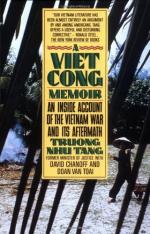
|
| Name: _________________________ | Period: ___________________ |
This test consists of 15 multiple choice questions and 5 short answer questions.
Multiple Choice Questions
1. What was Sihanouk's title in Cambodia in early 1970?
(a) Administrator.
(b) Commander.
(c) Prince.
(d) Chief.
2. Where does Tang and his wife live after he decides to go into seclusion??
(a) Upstate New York.
(b) Go Vap.
(c) Kratie.
(d) On the Ho Chi Minh Trail.
3. What did Tang's host want most to know from Tang during his visit to Budapest ?
(a) Whether he was happy to be gone from Russia.
(b) Why the Party was allying itself with the Soviets.
(c) Vietnam's position on the Sino-Soviet dispute.
(d) How much support Hungary could give the PRG.
4. What new means of transportation was Vietnam inundated with in 1969 and 1970?
(a) Volkswagens.
(b) Mopeds.
(c) Itallian bicycles.
(d) Japanese motorbikes.
5. According to Tang in Chapter 16, how did America regard the country of Vietnam?
(a) As an independent nation.
(b) With a view toward economic progress.
(c) As a country of people to be saved.
(d) As a pawn of strategy.
6. When Tang revisited Hanoi in 1974, what did he note about the Ho Chi Minh Trail?
(a) The route had become a system of two-lane roads.
(b) The original paths had grown dense with jungle foilage.
(c) Transportation was non-existant.
(d) The dirt paths were unchanged from years past.
7. What break came to Tang and his wife via his wife's brother-in-law?
(a) A job prospect without being in the government.
(b) They were able to sell their cottage at a profit.
(c) The prospect of escape by boat.
(d) An opportunity to showcase Tang's war efforts.
8. When the Ho Chi Minh trail was originally blazed in 1959, how many kilometers were the fighters expected to be able to advance every day?
(a) About 10.
(b) 15 or more.
(c) Nearly 20.
(d) Only 1.
9. What was the main goal of the Provisional Revolutionary Government, organized in 1969?
(a) To win the war by force and oust American forces.
(b) To represent the Northern Vietnamese.
(c) To influence public opinion on different fronts.
(d) To look better in the eyes of the Communist Party.
10. What were "elephant's intestines?"
(a) The belts on the guerrillas' pajamas.
(b) Poisonous snakes.
(c) Long tubes of rolled cotton.
(d) Moneys cooked in a pot.
11. How did Nixon and Kissinger justify the Tet offensive bombings and invasion of Cambodia?
(a) It brought an end to the American anti-war protests.
(b) It gained an essential year of time.
(c) A propaganda war of words was won.
(d) It increased American unity.
12. What was the prime enemy of the guerrillas considered to be in the jungle?
(a) The Americans.
(b) Nguy.
(c) The Saigon troops.
(d) Malaria.
13. What nickname did Madame Phat receive after she spoke of her debt of gratitude to the Party?
(a) Keeper of Bourgeois Reality.
(b) Humorless Madame Phat.
(c) Guardian of the Pagoda.
(d) Proletariat Phat.
14. Why were the dates of June 6th through 8th chosen to organize the congress for the Provisional Revolutionary Government?
(a) To honor Ho Chi Minh's birthday.
(b) To upstage a Nixon-Thieu meeting being held on Midway Island.
(c) To commemmorate the founding of the NLF.
(d) The dates are anniversaries of grandparents' deaths.
15. What were all of the attendants aware of at the PRG meeting in January of 1972?
(a) They were losing the war.
(b) Their struggle was reaching a turning point.
(c) That the Soviets and China were pulling away.
(d) Cambodia would take over Vietnam.
Short Answer Questions
1. What did the Party ideologues decide the NLF troops should do for three months in Kratie?
2. What happened when the city of Hue was taken by the NLF and Northern troops in January, 1968?
3. Who was the only professional sailor on board the boat Tang and his wife escaped on?
4. What did the term "neutralize" mean within the context of the Phoenix Program?
5. Upon Tang's return to Hanoi in Chapter 20, what does he encounter in the city he has not visited for thirty years?
|
This section contains 676 words (approx. 3 pages at 300 words per page) |

|




